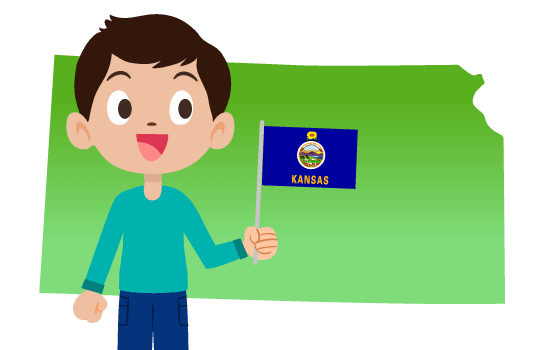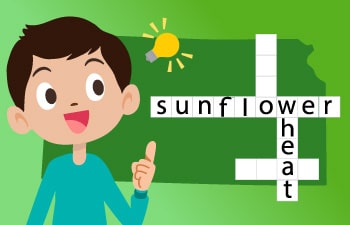What is the state animal of Kansas? The buffalo is the official state animal! Learn more about Kansas’s state symbols, historical facts about Kansas, a Kansas history timeline, geography facts and more in this unit study supplement.
Did you know that two military posts, Fort Leavenworth and Fort Riley, are important training centers located in Kansas? Did you also know that Kansas contains the geographic center of the continental US? A flag marks the spot in a pasture near Lebanon, close to the Nebraska border, and this spot serves as a reference point for all land surveyed in the US, Canada, and Mexico!
Keep reading to learn more interesting facts about Kansas. Time4Learning members can download our list of PreK-12 interactive activities that align with your study of Kansas. Here are a few Kansas facts for kids:
Kansas Fast Facts
|
Became a State: |
January 29, 1861 |
|---|---|
|
Order it Joined the Union: |
34th state |
|
State Capital: |
Topeka |
|
State Abbreviation: |
KS |
|
Border States: |
|
|
State Flag: |
|
|
State Song: |
|
|
State Flower: |
Sunflower |
|
State Nickname: |
|
|
Notable Kansans: |
|
Historical Facts About Kansas
Archaeologists have found evidence of humans in Kansas from as long ago as 12,200 years. Mammoths and other creatures have been found along with markings from human tools. Eventually, Native American people included the Comanche, Kansa, Kiowa, Osage, and Pawnee tribes. In fact, “Kansas” comes from the Kansa tribe and means “People of the South Wind.”
Francisco Vásquez de Coronado of Spain was the first European to reach Kansas back in 1541 when he and his crew were searching for the legendary cities of gold. Not finding such cities, the Spanish moved on, leaving the opportunity for the French to claim ownership. The US bought the land that is now Kansas from the French in 1803 as part of the Louisiana Purchase, and Kansas became our 34th state in 1861 at the beginning of the American Civil War.
Kansas, later known as “Bleeding Kansas,” was the site of hundreds of incidents between proslavery and anti-slavery groups. In 1854, the Kansas-Nebraska Act was passed, opening both territories to settlement and allowing residents to vote on whether slavery should be legal. As proslavery and anti-slavery groups rushed to settle the territories, conflict arose.
Southern guerrillas attacked Lawrence in 1856. Abolitionist, John Brown, and his anti-slavery group retaliated by killing five pro-slavery neighbors in what is now known as the Pottawatomie Massacre. Proslavery forces were then captured by Brown, who became a hero to the anti-slavery movement. These events were followed by many other incidents, but Kansas eventually entered the Union as a free state.
Throughout its history, Kansas has been a leader in women’s rights. Its first legislature in 1861 gave women the right to vote in school elections, own property, and have control of children. The right to vote for women was extended to city and bond elections in 1887. Also that year, the first female mayor in the US was elected in Argonia.
In 1978, Kansan Nancy Landon Kassebaum was the first woman to win an elected seat in the US Senate, and the universal right to vote for women was granted throughout the state in 1912. Women’s right to vote in the US, under the 19th Amendment, wouldn’t be official until eight years later in 1920! Today, Kansas ranks among the highest states in proportion of women holding public office.
Now take a look at the Kansas history timeline below to learn more important historical facts about Kansas.
1541
First explored by Francisco Vásquez de Coronado in his search for cities of gold1682
French explorer, René-Robert Cavelier, sieur de La Salle, claimed the land for France1803
US purchased the area from France as part of the Louisiana Purchase, a $15 million land deal promoted by President Thomas Jefferson1806
Explorer, Zebulon Montgomery Pike, passed through Kansas and described it as the “Great American Desert,” creating an image that led settlers and miners to pass through without staying1830-1854
Kansas was designated as an Indian Territory (for relocated Native Americans, later sent to Oklahoma)1854
Kansas-Nebraska Act was passed1856
Pottawatomie Massacre1860-1861
“Buffalo Bill” William Mathewson hunted buffalo for starving settlers for the entire winter without pay1861
Kansas became the 34th state in the US under President James Buchanon (same year as the start of the American Civil War)1861
Topeka became the capital by popular vote (just beating Lawrence by about 2,700 votes)1867
Peace treaty was signed with the Native Americans in which the US agreed to build homes and provide money, clothing, and food in Oklahoma in exchange for the land (US did not honor the treaty, causing conflict when the Native Americans returned)1878
Last Native American raid1880
Kansas was the first state to adopt the prohibition of alcohol (preventing the manufacture and sale of alcohol)1948
Kansas repealed the prohibition of alcohol1951
Brown v Board of Education civil rights case originated in Topeka (establishing that “separate but equal” segregation was not allowed in schools)Bring history and geography to life with Time4Learning’s interactive online social studies curriculum for grades 2-12.
Kansas Geography Facts
The geography of Kansas is ideal for grasses (buffalo grass in the west; bluestem, switch, and Indian grass in the southeast, and bluegrass in the Great Plains). In the northeast, trees, such as cedars, maples, oaks, and walnuts, grow while the state is covered with wildflowers like the purple coneflower, verbena, prickly poppy, sunflower, and prairie phlox. The cottonwood (state tree) grows throughout Kansas.
Wildlife includes black-tailed jackrabbits, nine-banded armadillos, least shrews, and plains pocket gophers. There are also prairie lizards, Great Plains skinks, and prairie king and western worm snakes. Golden eagles, western meadowlarks (state bird), yellow-billed cuckoos, black vultures, quails, pheasants, and prairie chickens can also be found throughout the state. The deer population has increased again after near extinction, and the state animal, the buffalo, can be found only on private lands or in state parks today.
Start by exploring this map of Kansas to start getting familiar with the state. Then read through the Kansas geography facts listed here. Print out the map of Kansas provided below and add these items to the map.
- Kansas is bordered by Nebraska in the north, Oklahoma in the south, Colorado in the west, and Missouri in the east.
- The capital, Topeka, can be found in the northeastern part of the state on the Kansas River.
- The largest city in Kansas, Wichita, lies on the Arkansas River in the south-central part of the state.
- The Missouri River forms the northeastern border with Missouri.
- The Kansas River is located in the northeastern corner of Kansas and flows through Topeka.
- The Arkansas River connects Colorado to Oklahoma and passes through Wichita.
- The Republican River enters Kansas just east of the center of the Nebraska border.
- The Smoky Hill River flows across the northwestern corner of the state.
- Kansas has few natural lakes, but it has several reservoirs. Tuttle Creek Reservoir is in the northeastern part of Kansas on the Big Blue River (which flows in from Nebraska) close to where it meets the Kansas River.
- Other reservoirs include Clinton (near Lawrence), Milford (near Manhattan), and Wilson (near the center of the state).
- Kansas’s highest point is Mt. Sunflower at 4,039 feet above sea level, on the border with Colorado in the northwestern corner of Kansas.
- The lowest point is at the Verdigris River, located in the southeastern part of Kansas, at 680 feet above sea level.
Kansas State Map
Download our FREE Kansas state map printable. Use it as a coloring page or use it to plot the state’s geographical features.
Activities for Children in Kansas
If you are able to visit the state, you can learn fun facts about Kansas by experiencing them yourself. Homeschoolers in Kansas have the advantage because they don’t need to travel far, but visitors to the state shouldn’t miss out on the fun too! Here are a few places you will want to explore to learn more Kansas state facts:
- Eisenhower Presidential Library, Museum, and Boyhood Home (Abilene): Enjoy the museum exhibits that use technology and interactive activities to engage learners and see the childhood home of President “Ike” Eisenhower. Take advantage of the free Lunch & Learn series on the 4th Thursday of every month.
- Botanica, The Wichita Gardens (Wichita): Explore the many gardens of Botanica including the Downing Children’s Garden, the Chinese Garden of Friendship, the Shakespeare Garden, the Gene E. Spear Railroad Garden, and the Water Well Education Garden. Enjoy the Butterfly House and the Koi Pond. See the calendar for special events and lunchtime lectures.
- Flint Hills Discovery Center (Manhattan): Explore the 35,000 square foot culture and science museum through interactive exhibits, a theater experience, temporary displays, and the prairie-inspired terrace and trail. Learn about blowing winds, fire, shaping waters, and underground forest. See a film about microscopic “monsters.” Whether or not you can visit, check out the Flint Hills Learning Resources for lesson plans, project-based learning, and more.
- Strataca: Kansas Underground Salt Museum (Hutchinson): Come and see a working salt mine 650 feet below the surface of the earth whose salt was formed some 275 million years ago! Take the Safari Shuttle through miles of dark tunnels to see natural formations not often seen and enjoy the Dark Ride to learn about the challenges and solutions related to mine safety. See the Salt Resources section of the website for learning you can do at home.
- Old Cowtown Museum (Wichita): Sitting on 23 acres off the Chisholm Trail, it is one of the oldest open-air history museums in the Midwest. Visit the 54 historic and recreated buildings of a town set to look as it did in the 1860s and 1870s. Explore the schoolhouse, the jail, and the general store. See the more than 10,000 artifacts from the period between 1865 and 1880 and relive the days of “Billy the Kid.”
Kansas Freebies and Deals for Homeschoolers
Want to learn more Kansas facts and information without spending a fortune? Below are just a few ideas:
- Fort Larned National Historic Site (Larned): See a complete and authentic army post designed to protect the Santa Fe Trail during the 1860s and 1870s. Travel to Fort Larned’s Santa Fe Trail ruts site to view real ruts left by the wagons that used the Santa Fe Trail. Walk the nature trail and talk with historians or get a ranger-guided tour. Admission and activities are free.
- Kansas State Capitol (Topeka): Take a free historic tour of the Kansas State Capitol to see the Senate Chamber, Representative Hall, the Old Kansas Supreme Court, and the State Library of Kansas. Enjoy the galleries and murals throughout the building or climb the 296 steps during a regularly scheduled dome tour.
- The Keeper of the Plains (Wichita): Come to where the Arkansas and Little Arkansas Rivers meet to see the 44-foot-tall, 5-ton sculpture of an Indian Chief. In the evening, enjoy the “ring of fire” that surrounds the statue periodically. There is no charge for admission.
- Monument Rocks/Chalk Pyramids (Oakley): Come and see these 70-foot-tall sedimentary formations of Niobrara Chalk formed from erosion of a seabed that existed 80 million years ago. See embedded shells and other fossils in the rock formations as you explore this National Natural Landmark. Visitors are admitted free but must leave before sunset.
- Tallgrass Prairie National Park (Strong City): Visit what is less than 4% of the original 170 million acres of North American tallgrass prairie. Explore the 11,000 acres of protected prairie via bus tour or hike. Tour the historic ranch and one-room schoolhouse or take a “cell phone tour” to access information at a variety of sites. Maximum height of the tallgrass is in September or October: remember “Tall in the Fall”! There is no admission fee, and all activities in the park are free.
Kansas Learning Games for Children
Learned enough interesting things about Kansas? Test your knowledge of Kansas facts for students with these free games and activities:













